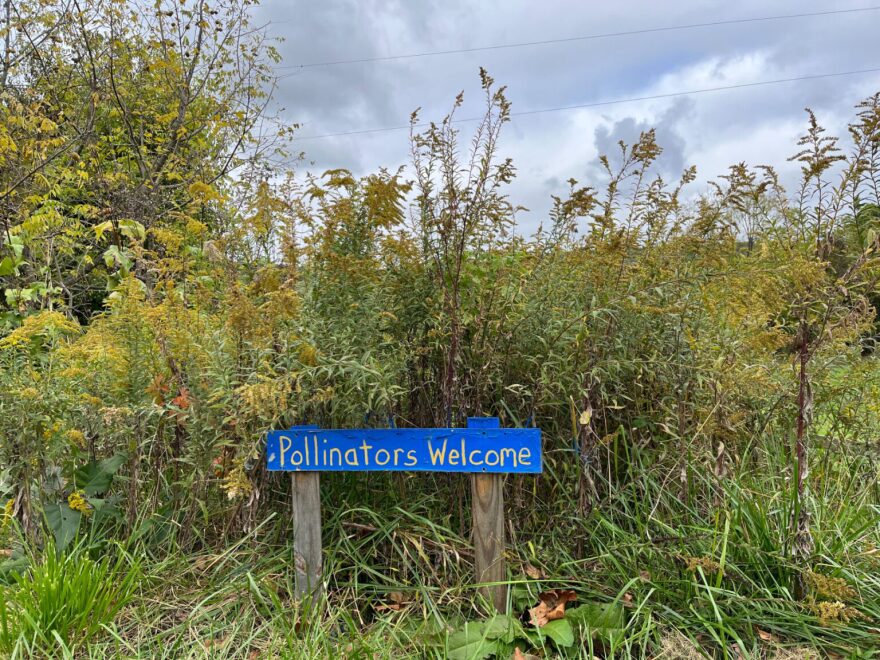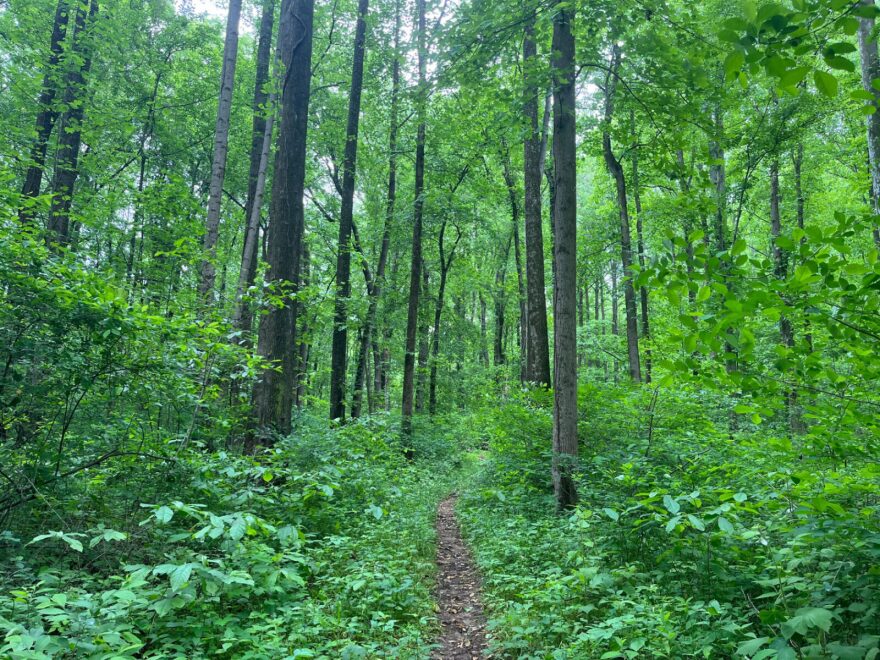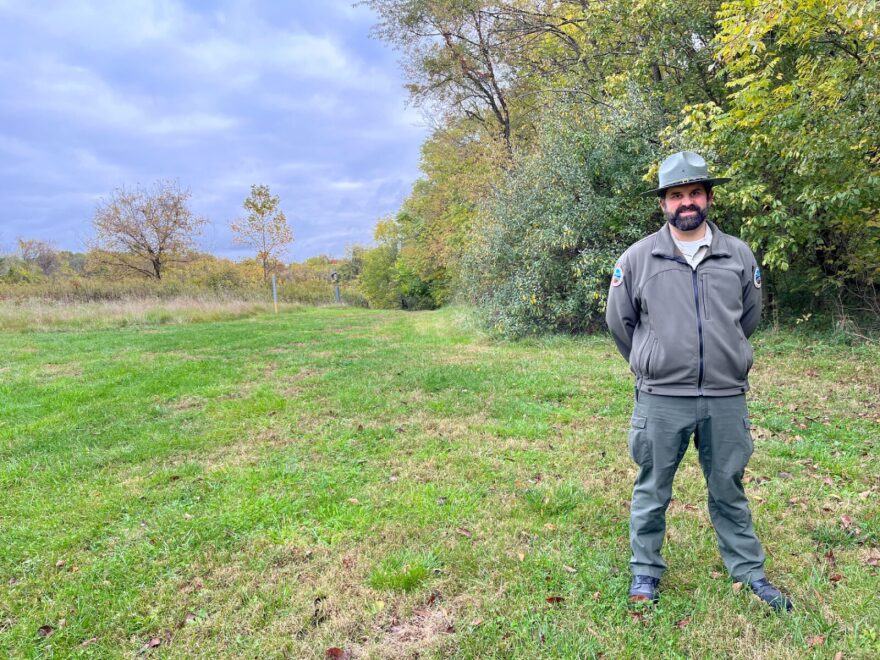Read the original story on WAMU/DCist's website.
It’s a crisp fall day in western Loudoun County, with dramatic gray clouds overhead and leaves hinting at turning yellow. In other words, a perfect day to explore Virginia’s newest state park.
Sweet Run State Park is nearly 900 acres of deep woods, open fields and wetlands just a few miles away from Harpers Ferry, in the Between the Hills Valley. Some of the area is former farmland — hard as that is to believe when you’re walking under a tree canopy. But scattered here and there are old farmhouses from the mid-1800s and later, peeking out through the trees and dense undergrowth.
“It’s these neat little gems,” says Kevin Bowman, the park manager at Sweet Run. “You walk around a corner like we are now, and suddenly behind the trees is an old mid-19th century farm structure.”
Sweet Run was only recently dedicated as a state park, but much of the land has been open to the public since 2004, when the private Leggett Foundation opened the Blue Ridge Center for Environmental Stewardship here. In 2016, the process of transitioning the land into a state park began in earnest, with the foundation handing off 600 acres to the Virginia Department of Conservation and Recreation.
The rest of the land — 280 acres purchased and donated by Loudoun County — was transferred to state management in early 2022, the same year Virginia lawmakers included funding in the state budget to hire the park’s first staff.
The park opened on a limited basis in May and officially became Virginia’s 42nd state park this month. Bowman says the rangers are already beginning to see an uptick in visitors. He expects fall and spring — the so-called shoulder seasons — to draw in the largest numbers from year to year.
‘Endless’ stories from the past
The park has an 11-mile trail network (most of which is also open to horseback riding) and a picnic pavilion people will soon be available to reserve for larger gatherings.
Bowman and I are walking the Farmstead Loop, an easy 1.5-mile path that meanders through a sampling of Sweet Run’s varied landscapes and history.
“Today, as we’re walking through here, it just seems like we’re in the middle of the woods,” Bowman says. “But in the mid-1800s into the 1900s, this would have been a community.”

Bowman is a self-proclaimed “history guy,” and he’s spent nearly a year studying old records and historical photos in preparation for the park’s opening. He carries a few old aerial photographs of the area with him on the trail. In a shot from 1937, much of the land closest to the park entrance is farm fields, eventually giving way to deeper, mature woods.
Some of the area has been farmland since the 1700s, according to Bowman. By the beginning of the Civil War, it was a “large, thriving community,” he says, complete with its own polling place.
The park, Bowman points out, is just a few miles away from Harpers Ferry and the confluence of the Shenandoah and Potomac Rivers, a major economic corridor and center of industry that was a highly fought-over area during the Civil War. Even before the war broke out, Harpers Ferry was the site of abolitionist John Brown’s famous raid, which stoked tensions between the North and the South.

From some parts of the park, you can see the ridge forming the border with West Virginia, which left Virginia in 1863 to join the Union and become a separate state. Just a few miles away lay Maryland, another Union territory that was also a slaveholding state whose population was divided on the issue.
All that makes Bowman wonder what life was like during the conflict, living so close to the border between the two sides. He imagines a community deeply divided over the question of slavery.
“That was right here in these people’s backyard,” he says. “And so it would have been very real.”
“The stories are just endless,” he adds.
The conservation conundrum
Nowadays the Farmstead Loop trail — likely a former road, Bowman says — runs through scrubby woods alongside Piney Run, one of the park’s two main waterways (the other is its namesake, Sweet Run). It’s a quiet morning, and the place does smell a little sweet, like damp leaves.
We pause at a clearing by a bend in the stream, a popular spot according to Bowman. You can practically see people stopping in the shade of the trees, maybe wading in the cool water on a steamy summer day.

But high-traffic areas like this one are a mixed blessing for the people in charge of taking care of them. Bowman points out signs of erosion: exposed, worn-down tree roots and dirt packed down by footsteps.
“Over the years, these things begin to have an impact on the ecosystem and watersheds and things like that,” he says.
That could mean damage for this habitat and harm to its wildlife, including a rare creature: the wood turtle, a reptile native to Virginia and threatened by habitat loss and illegal poaching to sell as pets. Herons, bald eagles, black bears, and many more animals also call this place home, according to Bowman.
It’s the classic conundrum of parks: preserving natural ecosystems while also opening them for people to enjoy. Bowman and his staff at Sweet Run encourage visitors to follow Leave No Trace principles and keep dogs on leash to help minimize their impact on the land and preserve it for future generations.
“We want to conserve this land and kind of lock in place these stories that were once here so that they’re not not lost on us 100 years from now,” he says.
An oasis in nature
Bowman knows personally as well as professionally why access to parks like Sweet Run is important. He first visited the area in May 2020, at the height of the pandemic. At the time, he was working as the park manager at nearby Sky Meadows State Park, which features a similar mix of forest and former farmland.
“All the grass areas were full of cars and, you know, people were out and enjoying themselves and … being able to escape from what was a very stressful time,” Bowman recalls.
The surge in hiking and outdoor recreation during the pandemic, Bowman hopes, will “leave a long-term legacy, an impact that people now understand and appreciate these outdoor spaces.”

We pause as the trail enters an older stretch forest with mature maple, beech, poplar and oak trees so tall and straight that you have to crane your neck to look at the canopy. The tangled undergrowth of the newer forest near Piney Run is gone, and you can see the contours of the hillside angling down towards a wetland area. At one point in the mid-1900s, the wetland was a man-made pond which narrowly escaped becoming a water feature on a proposed golf course development.
It’s now one of Bowman’s favorite places in the park.
“It’s kind of peaceful,” Bowman reflects. “I always enjoy places in the woods like this where you can see quite a ways.”
Towards the end of the hike, we walk out of the woods and into a meadow — more former farmland, Bowman says. Now, it’s got bluebird nesting boxes, a profusion of goldenrod, and an expansive view up to Short Hill Mountain and the Blue Ridge, which sandwich the Between the Hills valley. There’s some blue sky peeking through the clouds, promising a sunny fall afternoon.

Now that Sweet Run is open, Bowman has high hopes for ways to help people enjoy the park, including historical markers, public programs and maybe even a formal trail connection to the nearby Appalachian Trail. He hopes visitors can have the experience of piecing together the history of the land and how humans have changed it through the centuries.
He also knows there’s work to be done managing the invasive animal and plant species in the park, including the spotted lanternfly. Prioritizing much of that work will happen in the park’s upcoming strategic planning process, with the help of public input.
“We’re at our beginnings,” Bowman says. “Much of the excitement is yet to come.”





